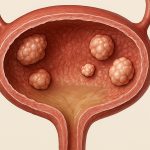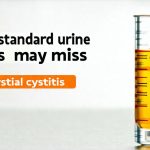Chronic pelvic pain is a debilitating condition affecting millions worldwide, often leading to significant disruptions in quality of life. The search for understanding its causes can be lengthy and frustrating for those affected, as symptoms frequently overlap between different diagnoses. Hunner’s ulcer, historically associated with interstitial cystitis (IC), now understood as part of the broader spectrum of chronic pelvic pain syndromes, presents a particularly complex challenge. Originally described as focal areas of inflammation in the bladder wall observed during cystoscopy, its role and even existence have been debated for decades, evolving alongside our understanding of IC itself.
The historical focus on Hunner’s ulcers as the defining characteristic of IC has gradually shifted. Modern research recognizes that many individuals diagnosed with IC do not exhibit these visible lesions, and conversely, some patients presenting with Hunner’s ulcers may have other underlying conditions. This highlights the intricate relationship between bladder health, pelvic floor dysfunction, nerve sensitivity, and psychological factors in chronic pelvic pain. Today’s approach to diagnosis prioritizes a holistic assessment of symptoms and findings rather than solely relying on cystoscopic evidence, acknowledging that IC/chronic pelvic pain is likely an umbrella term encompassing several distinct phenotypes with overlapping presentations.
Understanding Hunner’s Ulcer & Its Evolution
Hunner’s ulcer was initially described by Georg Hunner in the 1930s as small, pinpoint lesions found during bladder examination (cystoscopy) in patients experiencing chronic pelvic pain. These ulcers were thought to be a key diagnostic feature of interstitial cystitis, differentiating it from other causes of urinary symptoms. The prevailing theory at the time suggested that these ulcers represented areas of localized inflammation and damage within the bladder lining, contributing directly to the characteristic pain and urgency associated with IC.
However, as research progressed, inconsistencies arose. Many patients diagnosed with IC did not have visible Hunner’s ulcers during cystoscopy, leading to questions about their diagnostic significance. Furthermore, studies revealed that even when present, these lesions were not always correlated with a patient’s reported pain levels. This sparked debate within the medical community, challenging the long-held belief that Hunner’s ulcer was central to IC diagnosis and pathogenesis. Modern perspectives now view them as potentially representing only one manifestation of a much broader range of bladder abnormalities seen in individuals experiencing chronic pelvic pain.
The current understanding is that Hunner’s ulcers may indicate more severe forms of IC, often associated with greater pain intensity and impact on quality of life. They are also sometimes found in patients with other conditions mimicking IC symptoms, such as autoimmune diseases or infections. Importantly, the absence of Hunner’s ulcers does not rule out a diagnosis of IC/chronic pelvic pain; it simply suggests a different subtype or presentation. Understanding volume voided can also help with differential diagnosis.
The Link Between Hunner’s Ulcer & Interstitial Cystitis (IC)
The historical connection between Hunner’s ulcer and interstitial cystitis is undeniable, though increasingly nuanced. For many years, the presence of these ulcers was considered essential for diagnosing IC, forming part of the diagnostic criteria used by physicians. This led to a focus on identifying and treating these lesions as a primary goal in managing the condition. However, this approach proved problematic due to the low prevalence of Hunner’s ulcers in most IC patient populations and the lack of consistent correlation between their presence and symptom severity.
The shift in understanding recognizes that IC is not a single disease entity but rather a collection of overlapping syndromes with varying presentations. The original concept of IC centered around bladder-specific inflammation, but it’s now known that pelvic floor dysfunction, nerve hypersensitivity (central sensitization), immune system dysregulation, and psychological factors all play significant roles. Hunner’s ulcers are now considered to be more common in a specific subtype of IC – often referred to as ‘ulcerative IC’ or ‘Hunner-type IC’ – which tends to be associated with more severe symptoms and a potentially different underlying pathophysiology compared to non-ulcerative forms of the condition.
Patients presenting with Hunner’s ulcers may experience more intense pain, frequent urgency, and significant impact on their daily lives. The focus in these cases shifts towards managing inflammation, addressing bladder lining integrity, and mitigating nerve sensitization – a comprehensive approach that recognizes the complex interplay between physical and psychological factors contributing to chronic pelvic pain. Monitoring symptoms with a bladder diary can be extremely helpful in tracking progress.
Diagnostic Challenges & Cystoscopy Findings
Diagnosing IC, particularly identifying Hunner’s ulcers, can be challenging due to overlapping symptoms with other conditions like urinary tract infections, overactive bladder, and endometriosis. A thorough medical history, including detailed symptom assessment, is the first step. This involves exploring the nature of pain (frequency, intensity, location), urinary habits (frequency, urgency, nocturia), and any associated symptoms. Physical examinations, including pelvic floor muscle assessment, are also crucial to rule out other potential causes and evaluate for co-existing conditions like pelvic floor dysfunction.
Cystoscopy – a procedure where a small camera is inserted into the bladder – has traditionally been used to identify Hunner’s ulcers. However, even with cystoscopy, diagnosis can be tricky. The appearance of these lesions can vary significantly, and their identification relies heavily on the experience and expertise of the physician performing the procedure. Furthermore, hydrodistention during cystoscopy (filling the bladder with fluid) can sometimes reveal subtle abnormalities that are not visible when the bladder is empty.
It’s also important to note that the sensitivity and specificity of cystoscopy for diagnosing IC are limited. Many patients without IC may have minor superficial lesions in their bladders, while some patients with confirmed IC may not exhibit any visible ulcers during cystoscopy. Therefore, relying solely on cystoscopic findings is often insufficient for accurate diagnosis.
Beyond Cystoscopy: Comprehensive Assessment
Given the limitations of cystoscopy alone, a comprehensive assessment is crucial for diagnosing IC and identifying potential Hunner’s ulcers (or lack thereof). This includes several other diagnostic tools and considerations. Urodynamic testing assesses bladder function and capacity, helping to differentiate between different types of urinary dysfunction. Urine tests can rule out infection or other underlying medical conditions.
More recently, advancements in diagnostics have included evaluating biomarkers in urine that may indicate inflammation or immune system activity within the bladder. However, reliable biomarkers are still under development. Perhaps most importantly, a detailed assessment of pelvic floor muscle function is essential, as dysfunction in these muscles can contribute significantly to pelvic pain and urinary symptoms. Understanding voiding efficiency is also an important part of the process.
Finally, considering psychological factors is vital. Chronic pain often leads to anxiety, depression, and stress, which can exacerbate symptoms and interfere with treatment. Addressing these psychological components through therapy or counseling can be an integral part of a comprehensive management plan.
Treatment Approaches for Hunner’s Ulcer & IC
Treatment for IC/chronic pelvic pain, including cases involving Hunner’s ulcers, is often multimodal and tailored to the individual patient’s specific symptoms and findings. There isn’t a one-size-fits-all solution, as treatment effectiveness can vary significantly between individuals. For patients with Hunner’s ulcer, approaches may include intravesical therapies (instilling medications directly into the bladder) aimed at reducing inflammation and promoting healing of the bladder lining.
These therapies often involve substances like hyaluronic acid or chondroitin sulfate, which are thought to help repair damaged tissue and protect the bladder wall. Other treatment options can include oral medications to manage pain and urinary symptoms, pelvic floor physical therapy to address muscle dysfunction, and lifestyle modifications to minimize irritants that may exacerbate symptoms (e.g., dietary changes).
For patients experiencing significant nerve sensitization, treatments aimed at modulating nerve activity – such as low-dose amitriptyline or neuromodulation techniques – may be considered. It’s also important to emphasize the role of psychological support in managing chronic pain. Cognitive behavioral therapy (CBT) and mindfulness practices can help patients cope with pain, reduce stress, and improve their quality of life. Ultimately, a collaborative approach between patient and healthcare provider is essential for developing an effective and sustainable management plan.





















